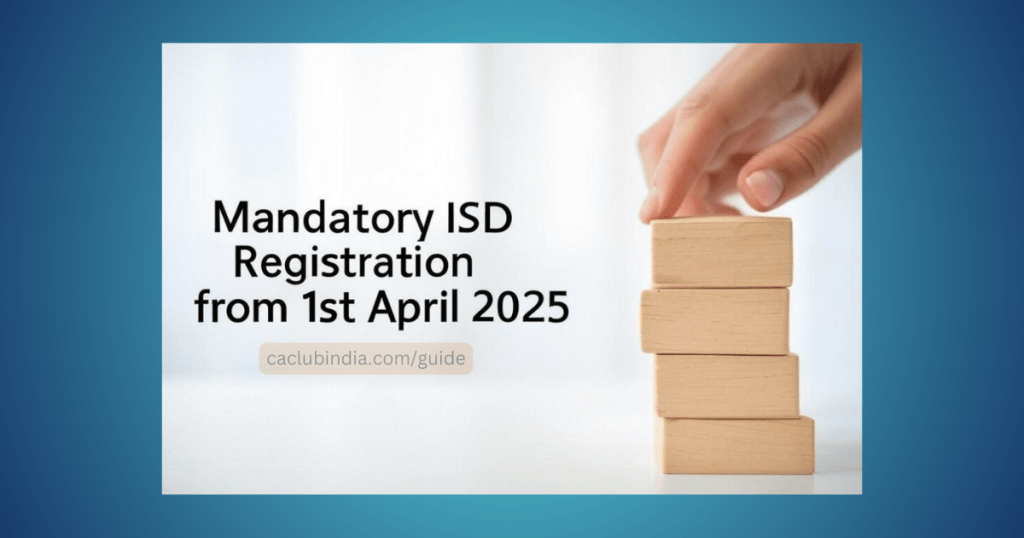
Input Service Distributor is an office of a business that receives invoices for input services and distributes the input tax credit (ITC) to its branches or units having the same Permanent Account Number (PAN).
The ISD mechanism is used when services are procured centrally but utilized across multiple locations. The ISD issues an ISD invoice to distribute the ITC appropriately to the consuming units, ensuring that the credit is utilized in the correct proportion.
Cross Charge Meaning
Cross Charge refers to the practice where services provided by one branch or unit of an organization to another are treated as supplies under GST. This is particularly relevant for internally generated services such as accounting, human resources, IT support, and management services.
Since branches in different states are considered distinct persons under GST, any supply of services between them is taxable, even if no consideration is exchanged. The valuation for such cross charges is typically determined based on the open market value of similar services or cost plus a certain percentage, as prescribed under Rule 28 of the CGST Rules.
Note – Concept of cross charge is not define under GST, however this concept drive from schedule I, supply of goods or services or both between related persons or between distinct persons even without consideration.
Scenario Up To 31.3.2025
Till 31.3.2025, most business use the method of cross charge for all supplies i.e. procured from third party as well as internally generated services. Circular No. 199/11/2023-GST dated 17 July 2023 also clarify that ISD registration is not mandatory in all cases.
Why Most Entity Prefer Cross Charge Instead Of ISD?
ISD required a separate registration in GST (along with normal registration), and it required to file GSTR 6 to distribute common input.
Also under ISD ITC is distributed on the basis of turnover. On the other hand under cross charge only an invoice is required to distribute expenses and expenses can be distributed on the basis of open market value.
Update From 50th GST Council Meeting
However in 50th GST council meeting it is recommend that “to clarify through a circular that Input Services Distributor (ISD) mechanism is not mandatory for distribution of input tax credit of common input services procured from third parties to the distinct persons as per the present provisions of GST law, and also to clarify issues regarding taxability of internally generated services provided by one distinct person to another distinct person.
The Council has also recommend that amendment may be made in GST law to make ISD mechanism mandatory prospectively for distribution of input tax credit of such common input services procured from third parties”. Now in certain cases it is mandatory to distribute ITC through ISD mechanism only.
Mandatory ISD Registration w.e.f 1st April 2025
After the recommend of 50th GST Council meeting, amendment came in Finance Act, 2024 to amend the definition of ISD and provision of sec 20 [Manner of distribution of credit by Input Service Distributor] w.e.f 1.4.2025
Services procured from third party – In case of services procure from third party it is now mandatory to distribute the same through ISD channel only and cross charge method cannot use in this case. Some important point need to consider are as follows-
- Separate GST required for ISD
- Input service invoice must be in GSTIN of ISD
- GSTR 6 to be file to transfer ISD input
- Input shall be distribute as per 39
The objective of this amendment is to streamline ITC distribution, promote uniform compliance, and enable centralized credit management.
Compliance Requirements for ISDs
ISDs must adhere to specific compliance requirements under GST:
Registration Process
You can apply via Form GST REG-01, selecting the ISD option under Serial No. 14.
No turnover threshold applies, registration is compulsory for eligible entities.
Invoicing
ISD invoices must include the name, address, GSTIN of the ISD and recipient, a unique serial number, taxable value, GST rate, and amount of credit transferred.
Filing GSTR-6
ISDs are required to file GSTR-6 monthly by the 13th of the following month. This return reports the ITC distributed to branches and includes details of ISD invoices issued.
Auto-Population in GSTR-6A
Recipient branches can view the distributed ITC in their GSTR-6A, which is auto-populated based on the ISD’s GSTR-6 filing.
Claiming ITC
Branches claim the distributed ITC in their monthly GSTR-3B returns.
Conclusion
The Input Service Distributor mechanism under GST is a critical tool for businesses with multiple branches, enabling efficient distribution of Input Tax Credit (ITC) for common input services.
While the ISD mechanism was optional until recently, the Finance Act, 2024, has made it mandatory from April 1, 2025, for businesses with multiple GSTINs under the same PAN. This change aims to streamline ITC distribution and enhance compliance but requires businesses to adapt their processes.